Menus
- Super sports cars from BMW, Honda, Kawasaki, MV Agusta and Yamaha
- PS judgment
- Technical data: BMW
- Technical data: Honda
- Technical data: Kawasaki
- Technical data: MV Agusta
- Technical data: Yamaha
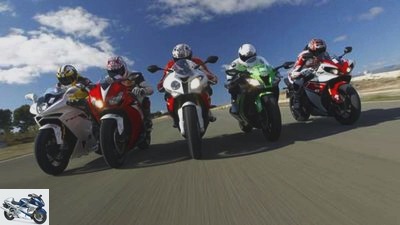
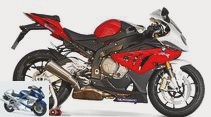
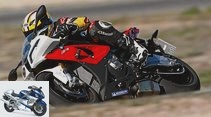
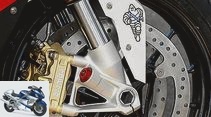
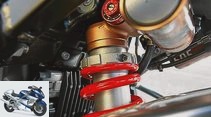
32 photos
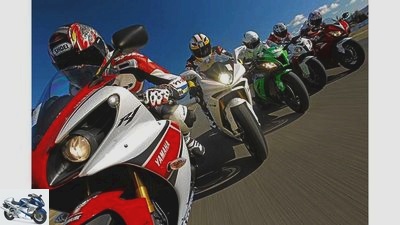
1/32
Yamaha YZF-R1, MV Agusta F4 RR, Kawasaki ZX 10-R, BMW S 1000 RR and Honda Fireblade C-ABS in the supersport comparison test. Which four-cylinder makes the race?

2/32
BMW S 1000 RR.
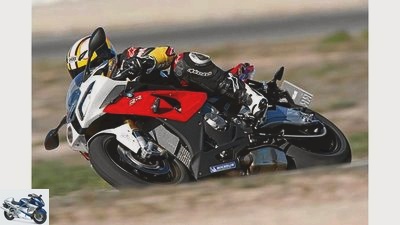
3/32
“F ** k, f ** k, f ** k, driving a BMW is like cracking nuts with a sledgehammer. You really have to know what to do with her and when “- Trevor Franklin for MCN (GB).
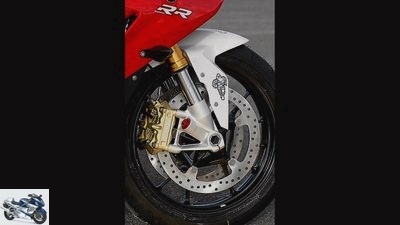
4/32
As usual, the BMW brakes are toxic.
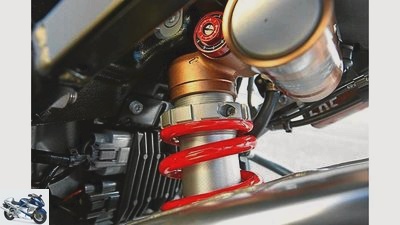
5/32
The firmer BMW chassis is a plus on the racetrack.
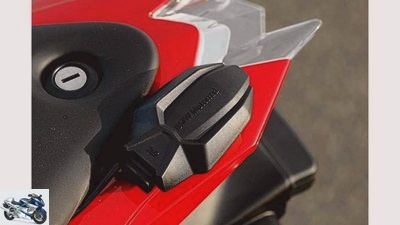
6/32
Unfortunately, recording costs extra.
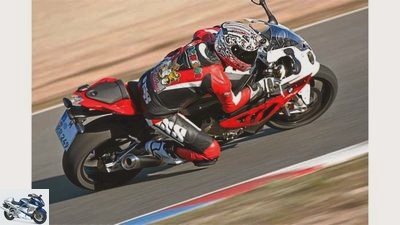
7/32
The BMW S 1000 RR on the racetrack.
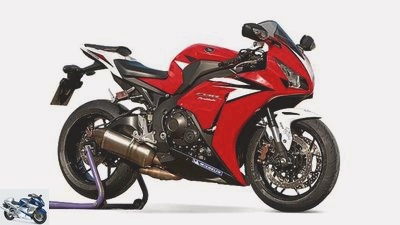
8/32
Honda Fireblade C-ABS.
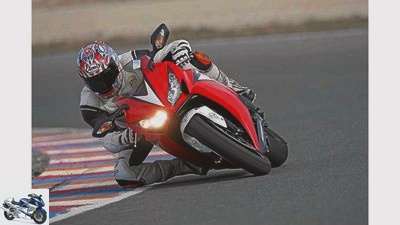
9/32
“For me, the Blade is the surprise of the test. The power is almost enough, the feedback is at a very high level and their manners are simply fantastic ”- Robert Gluck, PS tester.
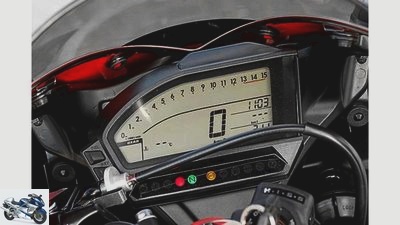
10/32
The great instrument is a blessing.
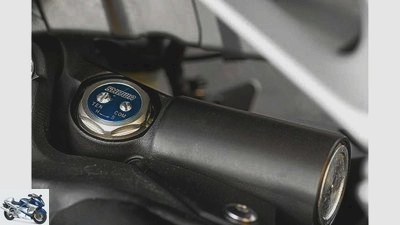
11/32
It is now difficult to get to the damper valves.
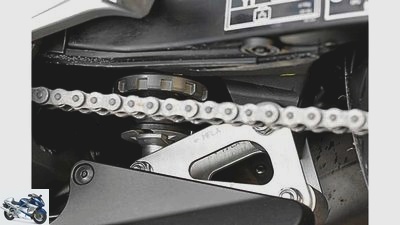
12/32
Progress along almost the whole line: The preload of the shock absorber is finally achievable.
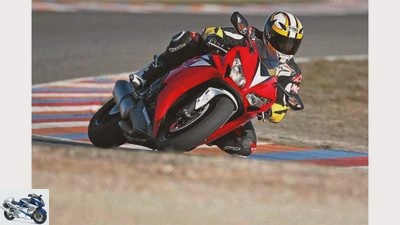
13/32
The Fireblade on the racetrack.
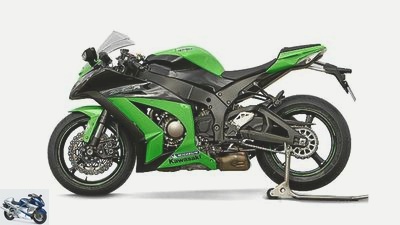
14/32
Kawasaki ZX-10R.
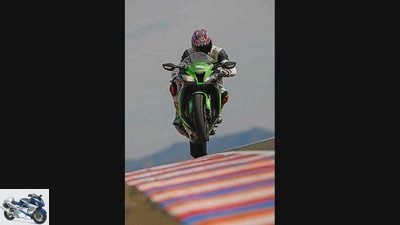
15/32
The ninja doing a wheelie.
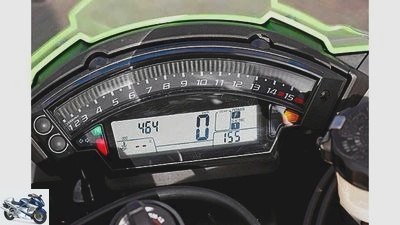
16/32
The rev counter also serves as a gearshift light, with consequences that cannot be overlooked.
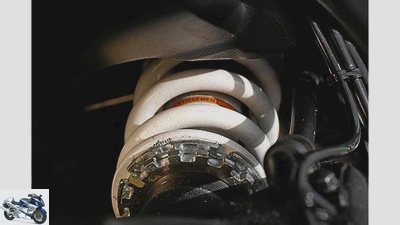
17/32
The lying strut is easily accessible.
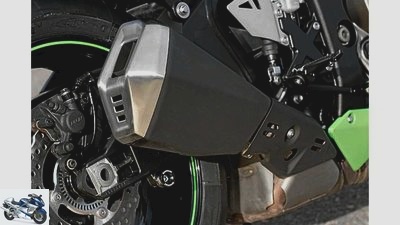
18/32
The Kawasaki exhaust is pleasantly quiet.
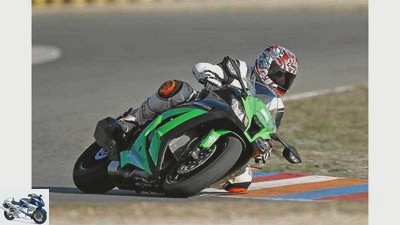
19/32
The Kawa on the racetrack.
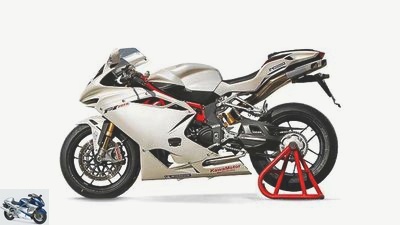
20/32
MV Agusta F4 RR.
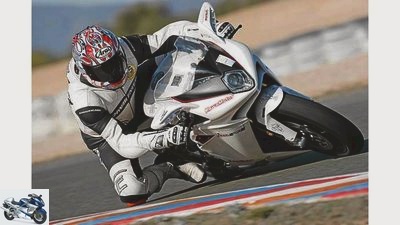
21/32
The MV is a large, stately motorcycle, but one that is much more agile than it looks. Their stability is still unmatched – Francesco Gulinelli for InMoto.
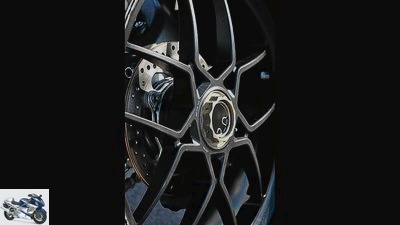
22/32
Finest components: forged wheels on the F4.
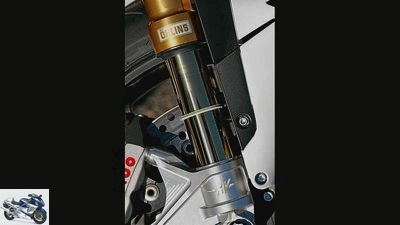
23/32
The MV has an Ohlins chassis.
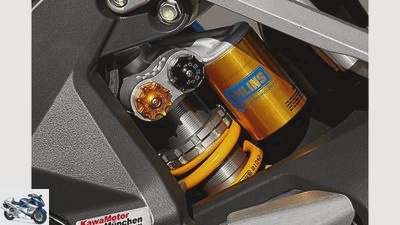
24/32
Complete Ohlins chassis not only ennoble the MV Agusta, but also ensure super-smooth road holding with great feedback.

25/32
MV Agusta F4 RR on the racetrack.

26/32
Yamaha YZF-R1.
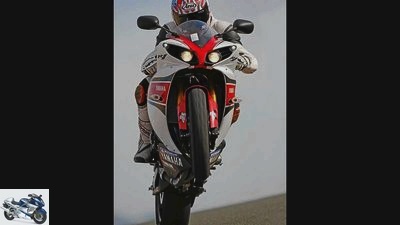
27/32
The Yamaha rear-wheeling.
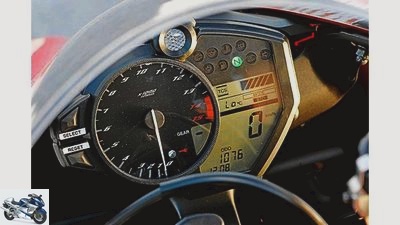
28/32
The discreet cockpit of the R1 is ok, the TC display (level 6) at the top right.
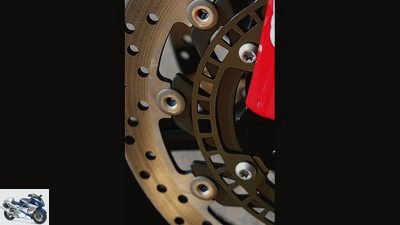
29/32
The sensor rim provides the front wheel speed of the R1.
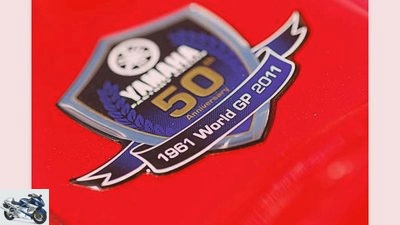
30/32
The 50th Anniversary Edition of the Yamaha.
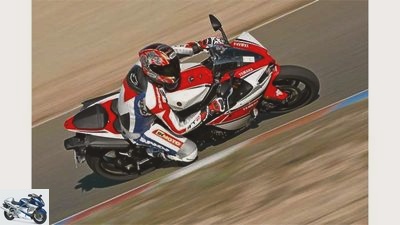
31/32
The R1 on the racetrack.

32/32
In the end, the BMW S 1000 RR wins the group test. Japan must finally wake up!
Comparison test: four-cylinder superbikes 2012
Super sports cars from BMW, Honda, Kawasaki, MV Agusta and Yamaha
Content of
Five inline four-cylinder superbikes compete against each other to choose the best of their group on the racetrack. Are there only hard facts that count or there is also time for feelings?
B.iest! She is just an incredibly powerful beast! Asks tremendously and at the same time gives so much back. It hits, bites, scratches and pushes you on and on. But one thing is clear: fun quickly becomes serious. Without maximum concentration … Au Cheek! The emotional world unfolds to its full extent: from the relaxed, first kick to razor-sharp tension. Just please be spared sheer horror.
The end of the straight flies towards me relentlessly. Slower objects on and fixed points next to the route blur past. Full concentration on the braking point! Now bravely pull the right lever, straighten your upper body and wait until the curbs on the left and right in the field of vision no longer hiss through as continuous stripes in the corner of the eye, but appear again as individually painted curbs. The maximum deceleration at the end of the 900 meter long straight brings me back from the intoxication of speed into reality, like Captain Kirk back his Enterprise from the speed of light. Riding a BMW S 1000 RR is a mental cinema in its most beautiful form.
I feel right at home because my synapses are linked to the S 1000 RR through a leather suit and seat pad. One becomes one. I succeed in every change of direction with precision, the fat power pushes forward in every position. Every now and then a gently scratching footrest reminds you that too much lean angle makes you slow, the flickering of the traction control (TC) in slick mode signals that you are currently operating within the control range. The feeling of walking this tightrope? Indescribably good. I feel invincible! Not a second of fear, not a moment of shock during the whole turn!
These are my feelings that are triggered by a 2012 BMW S 1000 RR on the Circuito de Almeria. But it is not alone in the box. In addition to her, there are other candidates for similarly fantastic driving experiences, crisp lap times and a tough fight for the crown of Almeria: The Honda Fireblade, the Kawasaki ZX-10R, the MV Agusta F4 RR Corsacorte and the Yamaha YZF-R1 are competing against the BMW . All five are fueled by in-line engines, which generate enough lard in their four cylinders to stretch our arms out.
But before we ignite the engines, a small update on the changes for 2012 in a nutshell: The BMW is actually a new motorcycle, which the Bavarians do not advertise at all. Fine-tuning everywhere; on the optics, the electronics and above all on the chassis. A new steering geometry and a higher pivot point give the S 1000 RR more agile handling. The brutal power of the Bayern power plant remained unchanged, but is now presented more emotionally thanks to new injection mappings. As long as you can even speak of “soulful” at 200 hp.
Honda’s Fireblade has been gently improved. Essentially, it received new chassis components with a new set-up and slight modifications to the programming of their injection system. The Akrapovic exhaust mounted on the test motorcycle comes from the Honda accessories and costs the customer a whopping 1185 euros extra. The Kawasaki was only launched in 2011 and, apart from the new color combinations, remains unchanged in 2012. The same applies to the MV Agusta F4 RR Corsacorte.
In contrast, the Yamaha YZF-R1 has been slightly modified for this season and is now equipped with six-stage traction control (TC). Optical retouching on the tank and fork bridge make the R1 more attractive. The TC and a new set-up of the injection system as well as a modified basic setup of the shock absorber should make them better and safer when accelerating on the racetrack.
In plain language, this means that the Japanese gently caressed their thousands, while BMW hardly left one stone unturned. So, in all seriousness, can we expect a shift in power in the superbike world? Does the BMW really have to fear losing its “King of the Ring” crown?
Hardly likely. A quick look at the performance curves determined by the test bench provides the first clues. BMW tops the group of five with 200 hp, followed by the Kawa with 193 hp and the MV with 190 hp. Then nothing comes for a long time before Yamaha and Honda break into the stable with 173 and 172 horses respectively. That sounds like an easy game for the Bavarian, because in terms of weight she ranks second behind the ZX-10R, which weighs only 203 kilograms, at 208.5 kilograms. Honda, Yamaha and MV Agusta are well over 210 kilograms. Data check finished, the truth is known to be different. But that’s why we have the race track. In order to keep the game fair, all five test motorcycles in Almeria are on the standard Michelin Power Cup tire with the front wheel variant “VA”, which promotes handling, but is not street legal. Each in the sizes 120/70 R-17 and 190/55 ZR-17, which in the case of the Honda (190/50 ZR-17 as standard) did not impair the ABS function or the driving stability in any way.
The BMW S 1000 RR on the racetrack.
BMW has already presented it. After the ride on the cannonball, a look at the lap times table is satisfying. Just as this series-produced BMW takes you and sucks the marrow out of your bones, it should destroy everything and everyone everywhere?
In fact, it combines three out of four sector best times. But it is only really dominant in the last sector, a perfect section of the track for our test purposes. Here it is important to accelerate from an opening right onto the very long straight. Then, just before shifting to sixth gear, at the end of the straight in the steep uphill braking zone, you have to decelerate decisively and shift down to second. And this is exactly where the BMW pours the Yamaha, which is also equipped with a TC, over one second per lap! The Honda without TC missed it there by just under a second and even pulled the 193 hp Kawasaki almost six tenths of a second over the skin. Just because of their superior power? No, because at least on the test bench it is no longer so superior if the Kawa hangs on it like a burr. The driving experience that the BMW generates makes the difference. The winning mixture, the magic potion that nourishes the driver’s self-confidence, emerges from the great interplay of steering precision, power and feedback. In addition, the finely working TC helps the pilot to open the gas very early and already in a great lean angle.
The S 1000 RR makes it to an impressive 271 km / h before it has to be braked again. Despite the rear wheel rising from time to time, the ABS does not intervene and you can turn into the next bend with a lot of pressure on the front wheel.
Keyword feedback: what the BMW delivers at a good level is topped by the oldest model in the test. When it comes to feedback from the front and rear wheels, the Honda Fireblade, which is equipped with the new Showa suspension elements, cannot be fooled! Let us again take the right on the straight line as an example. With the Blade, it is always approached on the same line, as if guided by an invisible hand, which always spits you out onto the straight in the best possible way. Thanks to the new single-point mapping, you can now apply the gas at the apex without the previously common, annoying load impact. Now you can pull the right handle really hard even in a deep incline. The crystal-clear feedback from the hindquarters makes a TC in the dry downright unnecessary for an experienced racer. The Honda reports very precisely about the condition of the rear skin. Which is sorely needed, because with 28 fewer horses on board than a BMW, the Honda has to take maximum momentum from the curve onto the straight. With these Honda qualities we don’t want to forget: This is a supersport test!
Logically, its 172 hp doesn’t push as powerfully as the 200 hp of an S 1000 RR, but that’s exactly what makes the difference. The Fireblade drives much less stress and lets the experienced pilot always have the upper hand. Be careful only when braking! If you want to brake very late with the Honda’s C-ABS, you need to know the following: Don’t build up the brake pressure suddenly, but slowly and gently. Never brake at the rear and only shift down into the correct gear and engage the clutch shortly before turning in. If one of the points is not observed, the ABS opens and the braking distance is unnecessarily extended. In general, the Firebalde prefers the soft driving style. Then their damping reserves play a role, which are a little tight on the shock absorber, and the “flow” sets in faster.
On the voting side, the next candidate, the Yamaha, is also on the comfortable side. But from 2012 it will be equipped with a TC at no extra charge, which will certainly make it easier to get out of the long right than the Honda. Or not? Even its unique sounding engine with a fat thrust in the middle turns you on and acoustically accompanies the acceleration orgy perfectly. The TC is set to level one (all other levels regulate much too early with racing tires and slow down), come crashing down at low altitude with dragging knees and pull up quickly but not hectically from the apex. The rear of the R1 literally digs into the asphalt and erases a thick black bar on it, while the dull, roaring sound wave carries you out into the straight, accelerating heavily. This feast for the ears gives you goose bumps under the leather. The gearbox is also a poem, the gears engage smoothly and precisely.
“For me, the Blade is the surprise of the test. The power is almost enough, the feedback is at a very high level and their manners are simply fantastic ”- Robert Gluck, PS tester.
But this recurring delight is followed by disillusionment when looking at the sector era. The Honda gives the Yamaha two tenths for this section of the route without TC – the same tires, the same driver, the same performance. How does it work? Just about the feeling. The forehand of the Yam mumbles, in contrast to the Honda, which is clearly articulated. And so you take that little bit more cornering speed and momentum out onto the straight on the Honda, which on the Yamaha only has to be caught up again with trust in the TC and more violent acceleration after the apex. However, the Honda also cuts a better figure on the brakes in a direct duel, which means that it stays in front of the R1 at the end of the straight.
And the Kawasaki? It clearly has the greatest potential and the best Japanese electronics package on board. But she literally gives it away. The green could really hit BMW if it weren’t for such a defensive translation. Unfortunately, it feels damn tame on the race below 7500 rpm. Only above that and with her TC at level one does she really go off. She fires out into the long straight in second gear, bravely holding the line and flying behind the BMW. It lacks a mere five km / h despite the too long secondary gear ratio to the top speed of the BMW. And it can also brake – like hell even. Your ABS does not regulate as late as that of the S 1000 RR, but not as early as that of the Blade. All of this somehow characterizes the ZX-10R perfectly: It can do everything well to very well, but nowhere is a highlight. Your engine reinforces this impression in another point: Although it has almost the same performance as the BMW, it runs much rougher.
And how is the second European doing in Almeria? Unfortunately, the MV Agusta does not have a lap time that can be used for the test, as it went down long before the lap timing session. Nevertheless, she completed enough meaningful laps to be able to say that the Corsacorte is a real MV. She can handle the hard pace, even literally screams for it. With its excellent Ohlins chassis and super stiff chassis, it can be beaten hard in the corners, does not deviate a millimeter from the track like a bloodhound in a hunting fever and delights the pilot with crisp feedback. Their razor-sharp steering precision and the snappy brakes add further highlights. All of this is pure racing! But where there is light, there is also shadow: Above all, the throttle response of the F4 RR and the power delivery were a thorn in the side of all testers. At 10,500 rpm, the rough-running four-cylinder jumped so violently and uncontrollably on the accelerator that at this point in time you definitely did not want to be in a deep lean angle. This did not change even after the TC was switched off, whose existence we doubt anyway. Pack up, discuss, weigh up. Each tester has his own style, his own preferences and everyone depends a little on their feelings. But in the end, these feelings do not deceive any of us, but rather produce a clear test result.
Europe agrees, speaks in a clear voice and is understandable for everyone: the BMW S 1000 RR asserts itself again and keeps its crown on its head – feelings regardless.
PS judgment
In the end, the BMW S 1000 RR wins the group test. Japan must finally wake up!
BMW S 1000 RR
The new BMW is better than the old one – and thus clearly the best superbike with an inline four-cylinder engine. Their dominance on an objective and subjective level is terrifying, Japan must finally wake up!
Kawasaki Ninja ZX-10R
The Kawa is like a Honda from the past – emotionless but good. Second in this test, it does a great job, and above all offers the full safety package with TC and ABS. But as I said, burning is also a matter of the heart.
Honda CBR 1000 RR Fireblade
A successful, targeted revision gives the blade wings. Measured against the competition, your performance is no longer up to date, but the existing performance can be perfectly implemented.
Yamaha YZF-R1
The R1 is also flourishing thanks to the facelift, but cannot eradicate old weaknesses in the area of the brakes and feedback. That costs a lot of points in such a tight and highly competitive test field.
MV Agusta F4 RR
The finest chassis components are from the cradle of the noble distiller from Italy. However, the uncultivated engine is not worthy of this ambience, which unfortunately depresses the overall performance.
Technical data: BMW
“F ** k, f ** k, f ** k, driving a BMW is like cracking nuts with a sledgehammer. You really have to know what to do with her and when “- Trevor Franklin for MCN (GB).
drive
Four-cylinder in-line engine, 4 valves / cylinder, 142 kW (193 hp) at 13,000 / min *, 112 Nm at 9750 / min *, 999 cm³, bore / stroke: 80.0 / 49.7 mm, compression ratio: 13, 0: 1, ignition / injection system, 48 mm throttle valves, mechanically operated multi-disc oil bath anti-hopping clutch, six-speed gearbox, G-Kat, chain, traction control
landing gear
Light alloy bridge frame, steering head angle: 66.0 degrees, caster: 99 mm, wheelbase: 1423 mm, upside-down fork, Ø fork inner tube: 46 mm, adjustable spring base, rebound and compression. Central spring strut with deflection, adjustable in spring base, rebound and compression (high / low). Suspension travel front / rear: 120/130 mm
Wheels and brakes
Cast light alloy wheels, 3.50 x 17 / 6.00 x 17, front tires: 120/70 ZR 17, rear: 190/55 ZR 17, test tires: Michelin Power Cup, 320 mm double disc brakes with four-piston fixed calipers at the front, 220 mm Single disc with single-piston floating caliper at the rear, ABS
measurements and weight
Length / width / height: 2020/800/1090 mm *, seat / handlebar height: 805/855 mm, handlebar width: 640 mm, 208.5 kg with a full tank, v./h .: 51.5 / 48.5%
Rear wheel power in last gear
137 kW (186 PS) at 273 km / h
consumption
Fuel type: Super unleaded. Average test consumption: k. A., tank capacity 17.5 liters, range: n / a.
Base price
16,100 euros (plus ancillary costs, ABS + DTC 1230 euros, automatic switch 364 euros, heated grips 197 euros)
Technical data: Honda
The Fireblade on the racetrack.
drive
Four-cylinder in-line engine, 4 valves / cylinder, 131 kW (178 PS) at 12000 / min *, 112 Nm at 8500 / min *, 1000 cm³, bore / stroke: 76.0 / 55.1 mm, compression ratio: 12.3 : 1, ignition / injection system, 46 mm throttle valves, mechanically operated multi-plate oil bath anti-hopping clutch, six-speed gearbox, G-Kat, chain
landing gear
Light alloy bridge frame, steering head angle: 66.8 degrees, caster: 96 mm, wheelbase: 1410 mm, upside-down fork, Ø fork inner tube: 43 mm, adjustable spring base, rebound and compression level. Central spring strut with deflection, adjustable in spring base, rebound and compression. Suspension travel front / rear: 120/138 mm
Wheels and brakes
Cast light alloy wheels, 3.50 x 17 / 6.00 x 17, front tires: 120/70 ZR 17, rear: 190/55 ZR 17, test tires: Michelin Power Cup, 320 mm double disc brakes with four-piston fixed calipers at the front, 220 mm Single disc with single-piston floating caliper at the rear, C-ABS
measurements and weight
Length / width / height: 2090/830/1130 mm, seat / handlebar height: 815/860 mm, handlebar width: 650 mm, 212 kg fully fueled, v./h .: 51.9 / 48.1%
Rear wheel power in last gear
119.8 kW (163 hp) at 255 km / h
consumption
Fuel type: Super unleaded. Average test consumption: n / a, tank capacity 17.7 liters, range: n / a.
Base price
14990 euros including C-ABS (plus ancillary costs, accessory exhaust 1185 euros)
Technical data: Kawasaki
The Kawa on the racetrack.
drive
Four-cylinder in-line engine, 4 valves / cylinder, 147 kW (200 PS) at 13,000 / min *, 112 Nm at 11,500 / min *, 998 cm³, bore / stroke: 76.0 / 55.0 mm, compression ratio: 13 , 0: 1, ignition / injection system, 47 mm throttle valve, mechanically operated multi-disc oil bath anti-hopping clutch, six-speed gearbox, G-Kat, chain, traction control
landing gear
Light alloy bridge frame, steering head angle: 65.0 degrees, caster: 107 mm, wheelbase: 1425 mm, upside-down fork, Ø fork inner tube: 43 mm, adjustable spring base, rebound and compression level. Central spring strut with deflection, adjustable in spring base, rebound and compression (high / low). Suspension travel front / rear: 120/140 mm
Wheels and brakes
Cast light alloy wheels, 3.50 x 17 / 6.00 x 17, front tires: 120/70 ZR 17, rear: 190/55 ZR 17, test tires: Michelin Power Cup, 310 mm double disc brakes with radially attached four-piston fixed calipers at the front, 220- mm single disc with single-piston floating caliper at the rear, ABS
measurements and weight
Length / width / height: 2130/900/1130 mm *, seat / handlebar height: 810/850 mm, handlebar width: 655 mm, 203 kg fully fueled, v./h .: 51.7 / 48.3%
Rear wheel power in last gear
134.5 kW (183 PS) at 280 km / h
consumption
Fuel type: Super unleaded. Average test consumption: n / a, tank capacity 17.0 liters, range: n / a.
Base price
16,495 euros (plus additional costs)
Technical data: MV Agusta
MV Agusta F4 RR on the racetrack.
drive
Four-cylinder in-line engine, 4 valves / cylinder, 148 kW (201 HP) at 13,400 / min *, 114 Nm at 9200 / min *, 998 cm³, bore / stroke: 79.0 / 50.9 mm, compression ratio: 13, 4: 1, ignition / injection system, 49 mm throttle valves, hydraulically operated multi-disc oil bath anti-hopping clutch, six-speed gearbox, G-Kat, chain
landing gear
Steel tubular space frame, steering head angle: 66.5 degrees, caster: 100 mm, wheelbase: 1430 mm, upside-down fork, Ø fork inner tube: 43 mm, adjustable in spring base, rebound and compression. Central spring strut with deflection, adjustable in spring base, rebound and compression. Suspension travel front / rear: 120/120 mm
Wheels and brakes
Forged light alloy wheels, 3.50 x 17 / 6.00 x 17, front tires: 120/70 ZR 17, rear: 190/55 ZR 17, test tires: Michelin Power Cup, 320 mm double disc brakes with radially attached four-piston fixed calipers at the front, 210- mm single disc with two-piston fixed caliper at the rear
measurements and weight
Length / width / height: 2100/830/1090 mm *, seat / handlebar height: 840/845 mm, handlebar width: 680 mm, 215 kg with a full tank, v./h .: 52.8 / 47.2%
Rear wheel power in last gear
129.5 kW (176 PS) at 271 km / h
consumption
Fuel type: Super unleaded. Average test consumption: n / a, tank capacity 17 liters, range: n / a.
Base price
22,900 euros (plus additional costs)
Technical data: Yamaha
The R1 on the racetrack.
drive
Four-cylinder in-line engine, 4 valves / cylinder, 134 kW (182 PS) at 12,500 / min *, 116 Nm at 10,000 / min *, 998 cm³, bore / stroke: 78.0 / 52.2 mm, compression ratio: 12 , 7: 1, ignition / injection system, 45 mm throttle valves, mechanically operated multi-disc oil bath anti-hopping clutch, six-speed gearbox, G-Kat, chain, traction control
landing gear
Light alloy bridge frame, steering head angle: 66.0 degrees, caster: 102 mm, wheelbase: 1415 mm, upside-down fork, Ø fork inner tube: 43 mm, adjustable in spring base, rebound and compression stage, central spring strut with deflection, adjustable in Spring base, rebound and compression (high / low). Suspension travel front / rear: 120/120 mm
Wheels and brakes
Cast light alloy wheels, 3.50 x 17 / 6.00 x 17, front tires: 120/70 ZR 17, rear: 190/55 ZR 17, test tires: Michelin Power Cup, 310 mm double disc brakes with four-piston fixed calipers at the front, 220 mm Single disc with single-piston floating caliper at the rear
measurements and weight
Length / width / height: 2090/775/1120 mm, seat / handlebar height: 820/840 mm, handlebar width: 650 mm, 215 kg fully fueled, v./h .: 52.0 / 48.0%
Rear wheel power in last gear
117 kW (159 PS) at 263 km / h
consumption
Fuel type: Super unleaded. Average test consumption: n / a, tank capacity 18.0 liters, range: n / a.
Base price
15,995 euros (plus utilities, only for 50th Anniversary Edition)
Related articles
-
BMW, Ducati, Suzuki and Triumph super sports cars in a comparison test
29 photos 1/29 Triumph Daytona 675, Ducati 848 Evo Corse SE, BMW S 1000 RR, Suzuki GSX-R 750. Different bikes – different cubic…
-
Comparison test: Ducati Diavel, Suzuki B-King and Yamaha Vmax
Jahn Comparison test: Power Bikes 2011 Ducati Diavel, Suzuki B-King and Yamaha Vmax Content of Big appearance, powerful sound waves, pressure from all…
-
Comparison test: large naked bikes
fact Comparison test: Large naked bikes, BMW K 1300 R, Honda CB 1300 S, Suzuki B-King, Yamaha XJR 1300 Large naked bikes in comparison Content of An…
-
Comparison test of the 1000 super sports car in 2006
fact Comparison test of the 1000 super sports car in 2006 The show must go on The mystery repeats itself. Whenever we think that nothing is going up, the…
-
BMW, Honda, Kawasaki, Suzuki and Yamaha super sports cars in a comparison test
Judd 26th photos Nicolaou 1/26 In the supersports comparison test: Kawasaki ZX-10R, BMW S 1000 RR, Suzuki GSX-R 1000, Honda Fireblade C-ABS and Yamaha…
-
Comparison test of super athletes under 1000 cubic meters
Jahn 22 pictures Jahn 1/22 The Kawasaki ZX-6R 636 wins the comparison test before the Suzuki GSX-R 750. Jahn 2/22 super sports car under 1000 cubic meters in the test. It…
-
Comparison test: power fun bikes
Fact 15th photos Fact 1/15 Benelli Tre-K 899 – Great feature: the spring base of the monoshock can be adjusted by handwheel. Fact 2/15 First place goes…
-
Comparison test: power naked bikes on the racetrack
Comparison test: naked bikes on the racetrack Country road fighter on the racetrack Content of It has to be extreme – that shows what is…
-
Comparison test: KTM Super Duke R against MV Agusta Brutale 990 R
Comparison test: KTM Super Duke R against MV Agusta Brutale 990 R Sporty naked bikes in the test Content of A feast for the senses: the new…
-
Comparison test: Honda CB 1000 R, Yamaha FZ1, Triumph Speed Triple, Kawasaki Z 1000
Comparison test: Honda CB 1000 R, Yamaha FZ1, Triumph Speed Triple, Kawasaki Z 1000 Large naked bikes in comparison Content of At its…